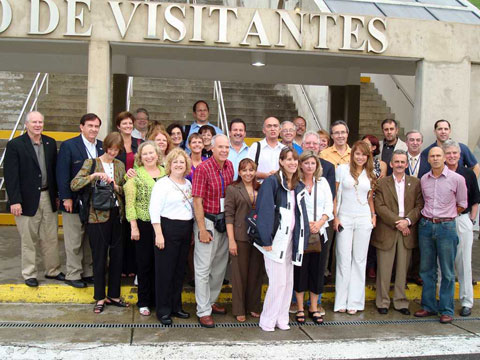By Senator Robert "Bob" Burns

Attendees of the 2008 American Telemedicine Association, Latin-American & Caribbean Chapter (ATALACC) meeting in Panama (Senator Burns is on the far left of this picture).
My wife Gayle and I recently returned from Panama (at our expense) after attending the Latin American Telemedicine Conference. In addition to the conference, we also visited two hospitals and a remote clinic on the Ngőbe-Buglé Indian reservation in the Panama jungle.
In 1995, I worked with legislative staffer John Lee to develop the Arizona Telemedicine Program model (ATP). Telemedicine is the use of telecommunications technology to provide training for healthcare providers and specialist consults to providers and patients who are located in areas that do not have that level of service available. The University of Arizona College of Medicine was directed to establish a pilot telemedicine program with eight sites to serve the Arizona prison system and rural underserved communities. The U of A recruited Dr. Ronald S. Weinstein, an international expert on telemedicine, to be director of the new Arizona state-wide program.
Dr. Weinstein and his staff, without increasing the original appropriations to the program, have grown the program through grants and a subscription membership model to more than 170 sites. To date, the ATP has facilitated the provision of medical services for over 600,000 Arizona patients.
The ATP has received numerous national and international awards for excellence demonstrating leadership in the telemedicine field. This demonstrated leadership resulted in Dr. Weinstein and his team’s invitation to be presenters at the Latin American Telemedicine Conference. This was a conference designed to educate health care providers through out Central America of the cost savings and enhancement of health care when using telemedicine systems.
During the original installation planning of sites for the Navajo Nation, a need for “through the air” confidential transmission of patient information presented a challenge. In 2001 the ATP, working with the United States Army Proving Grounds (YPG) in Yuma, came up with telecommunications technology to solve the problem. This cooperative effort between ATP and YPG led to a wireless technology that allowed YPG to move data at its test sites in Panama and also to provide telemedicine coverage for its personnel and the nearby rural Panamanian communities as well. This dual use application has enhanced the relationship between YPG and Panama. Panama provides an ideal climate (tropical jungle) for the testing of Army’s state-of-the-art transmission equipment.

Dr. Weinstein, Senator Burns in Cerro Iglesias, Panama Telemedicine Clinic Developed by the ATP and YPG.
Panama, like Arizona, has rural Indian reservations with transportation and transmission challenges that make providing quality medical care to these areas very difficult. The ATP, working with the University of Panama, was able to demonstrate the benefits of providing care using a telemedicine system. The telemedicine sites were developed in Panama, with ATP and YPG working together, to serve the rural Indian communities near its test sites.
In return, YPG now has a footprint in Panama providing ideal tropical conditions for the developing of new equipment and the testing of existing and new communications equipment. This medical care tool, that improves public health and safety in Panama as it does in Arizona’s rural communities, is a benefit which also provides a tremendous cost savings. Now the rural tribes, such as the Ngőbe-Buglé of Panama, have improved health care at a cost savings as well.